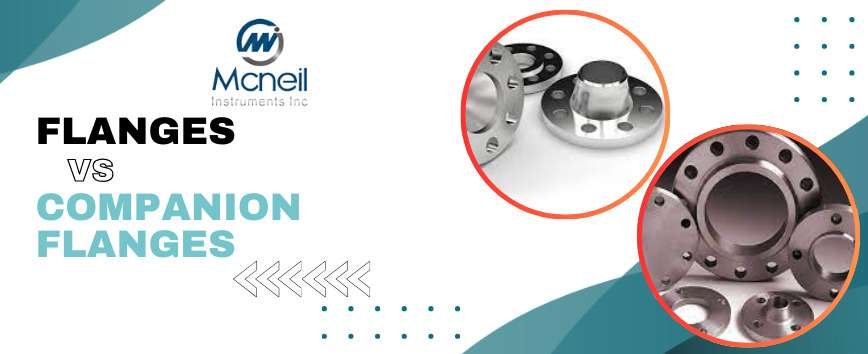Flanges and companion flanges play crucial roles in various industries, connecting pipes and facilitating efficient fluid or gas flow. While these terms may sound similar, they have distinct features and applications. In this comprehensive guide, we’ll delve into the differences between flanges and companion flanges, shedding light on their unique characteristics and applications.
Flanges The Backbone of Piping Systems
Definition and Function of Flanges
Flanges are essential components in piping systems, serving as connectors between pipes, valves, pumps, and other equipment. Their primary function is to provide a leak-tight seal, ensuring the safe and efficient transport of fluids or gases. Flanges come in various shapes and sizes, allowing for flexibility in design and application.
Types of Flanges
Weld Neck Flanges: These flanges are welded to the neck of the pipe, providing excellent strength and durability. They are commonly used in high-pressure and high-temperature applications.
Slip-On Flanges: Easy to install, slip-on flanges slide over the pipe and are then welded in place. They are suitable for low-pressure and non-critical applications.
Blind Flanges: Also known as blanking flanges, blind flanges seal the end of a pipe or valve. They are used to close off a pipeline temporarily or permanently.
Socket Weld Flanges: These flanges have a socket that allows the pipe to fit inside, creating a strong and reliable connection. They are commonly used in smaller pipe sizes and high-pressure applications.
Lap Joint Flanges: Lap joint flanges are used in conjunction with a stub end, providing easy alignment and assembly. They are suitable for systems requiring frequent dismantling.
Companion Flanges, A Specialized Connector
Definition and Purpose of Companion Flanges
Companion flanges are a specialized type of flange designed for specific applications, often in industries where precision and alignment are critical. Unlike standard flanges, companion flanges have a unique design that includes a set of bolt holes and a raised face to ensure accurate alignment during installation.
Unique Features of Companion Flanges:
Bolt Holes and Alignment: Companion flanges are equipped with precisely spaced bolt holes, facilitating accurate alignment during assembly. This feature is crucial in applications where misalignment can lead to operational issues or leaks.
Raised Face: The raised face of companion flanges helps create a tight seal when connected to a matching flange. This design minimizes the risk of leakage, making companion flanges suitable for applications demanding a high level of integrity.
Common Materials: Companion flanges are often made from materials such as stainless steel, carbon steel, or alloy steel, depending on the specific requirements of the application. The choice of material ensures durability and corrosion resistance.
Differences Between Flanges and Companion Flanges
Design and Application:
Standardization: Flanges come in various designs and configurations, making them versatile for a wide range of applications. On the other hand, companion flanges have a more specialized design, often tailored to specific equipment or systems.
Companion Flanges: The unique design of companion flanges with precisely spaced bolt holes and a raised face enhances alignment precision, ensuring a tight and leak-free connection. While standard flanges also provide a secure seal, companion flanges excel in applications where precise alignment is crucial.
Versatility: Flanges are highly versatile and can be used in various industries and applications. They are available in different types and sizes, allowing for flexibility in designing piping systems. Companion flanges, however, are more specialized and are typically chosen for specific equipment or systems where their unique features are essential.
Applications and Industries
Flanges in Various Industries:
Oil and Gas: Flanges are widely used in the oil and gas industry for connecting pipelines, valves, and equipment. The versatility of flanges allows for easy customization to meet the diverse needs of this sector, from exploration to refining.
Chemical Processing: In chemical plants, where corrosive substances are handled, flanges play a crucial role in creating secure connections that withstand harsh chemical environments. The choice of materials for flanges is often tailored to resist corrosion and maintain structural integrity.
Water and Wastewater Treatment: Flanges are integral to water and wastewater treatment facilities, connecting pipes and equipment in the transportation and processing of liquids. Their durability and ability to maintain leak-tight seals are essential for the efficient functioning of these systems.
Companion Flanges in Precision Applications
Aerospace: Companion flanges find applications in aerospace engineering, where precision and alignment are critical. They are used in various components, such as fuel systems, hydraulic systems, and engine assemblies, ensuring secure connections that meet stringent performance standards.
Automotive Manufacturing: In the automotive industry, companion flanges are employed for precise connections in manufacturing processes. They contribute to the efficiency and reliability of production lines, where accuracy and alignment are essential for seamless assembly.
High-Performance Machinery: Companion flanges are often utilized in high-performance machinery, such as turbines, pumps, and compressors. The precise alignment they offer is crucial for maintaining optimal performance, reducing wear and tear, and prolonging the lifespan of the equipment.
Maintenance and Considerations
Flange Maintenance:
Inspection: Regular inspections of flanges are essential to identify signs of wear, corrosion, or damage. Timely detection allows for preventive maintenance, preventing leaks and ensuring the longevity of the piping system.
Gasket Replacement: The gasket, positioned between flange faces, may degrade over time. Regular inspection and replacement of gaskets help maintain a reliable seal, preventing leaks and system failures.
Companion Flange Considerations:
Precision Maintenance: Due to their specialized design, companion flanges require precise maintenance to ensure proper alignment. Bolts should be tightened to the recommended torque values, and any misalignment issues should be promptly addressed.
Material Compatibility: Considering the specific requirements of the application, companion flanges should be made from materials compatible with the substances being transported to ensure durability and performance.
Conclusion
while both flanges and companion flanges play vital roles in piping systems, they differ in design, application, and functionality. Flanges offer versatility for a broad range of applications, whereas companion flanges provide precision and alignment in specialized scenarios. Understanding the distinctions between these two components is crucial for selecting the right option for a particular piping system, ensuring optimal performance, efficiency, and safety.





